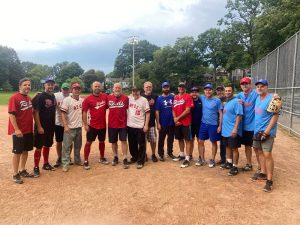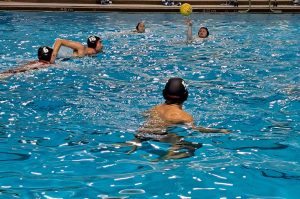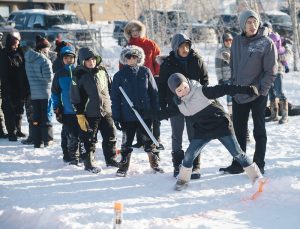Indigenous people have diverse histories, traditions and cultures, including their own games and sports that teach important survival skills and build agility, strength, accuracy and balance. Learning about and participating in these sports are also great opportunities for non-Indigenous people to gain a deeper understanding of the cultures, history and ancestral presence of First Nations, Inuit and Métis people.
Learn about the origins of and how to play three traditional Indigenous sports:
1. Kneel jump
Kneel jump is one of many Arctic sports (also called Inuit games or Northern games) featured at the Arctic Winter Games. Athletes get three attempts to jump as far as they can starting in a kneeling position with their feet flat underneath them and their buttocks on their heels. Kneel jump is a game of agility that activates your body’s core muscles.
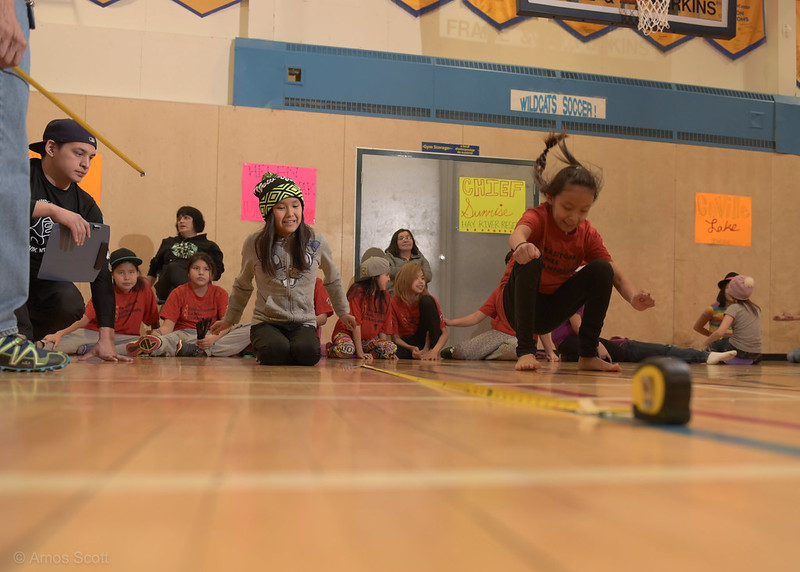
History of kneel jump
The Inuit played kneel jump to help improve their speed, agility and balance. For instance, if hunters had to face predators or injured animals, they needed to be quick to avoid getting harmed by them. Kneel jump also helped ice fishers and hunters move fast across the ice to safety if the ice started to break. This game also helped with the technique required for other agility games like the one-foot high kick and two-foot high kick.
What you need to play kneel jump
- Masking tape
- A tape measure
How to play kneel jump
- Use the masking tape to mark the designated starting/jumping line.
- To begin, kneel with your shins flat on the ground, feet pointed and tucked flat beneath your buttocks. Your knees should line up with the designated starting line.
- Use up and down arm movements as momentum to “pendulum” and help thrust your body upward and forward.
- You should land on both feet, about shoulder-width apart, while keeping your balance.
- Each player gets three tries to successfully jump as far as they can. The longest distance of the three tries is taken, as measured with the tape measure from whatever back heel is closest to the starting/jumping line.
2. Snow snake
Snow snake is one of five Dene games, competitive sports invented by the Dene or Northern Athapaskan peoples that test physical and mental skill. Played during winter, competitors throw a 1.4 m spear (typically carved from a spruce tree) underhand and along a snow–covered surface as far as they possibly can. The athlete who throws the spear the farthest wins. Players can run up to 7.62 m before each throw. Snow snake tests players’ accuracy, power and technique.
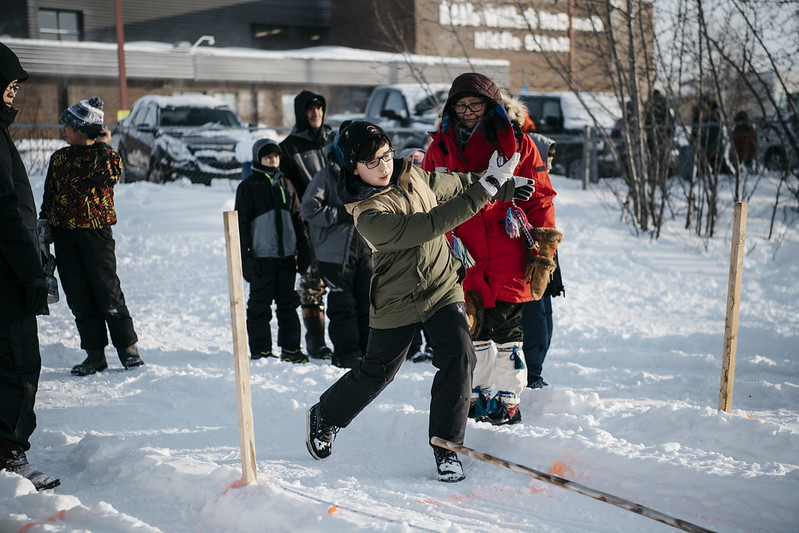
History of snow snake
Snow snake was originally played to teach Dene men how to hunt game such as caribou. Dene hunters would sneak on to snow-covered lakes where the caribou rested and throw spears along the snow to pierce and kill the animals. Because great skill and accuracy was required for this, hunters practiced this technique, which eventually became known as the snow snake game. Even though it’s considered a Dene game, other Indigenous peoples play snow snake or versions of it, including the Haudenosaunee and Ojibwa.
What you need to play snow snake
- A dry spruce or pine stick that’s ideally 1.4 m (4’6’’) long and 31.75 mm (1’ ¼”) in diameter. Its surface should be filed, planed, sanded smoothly and pointed at one end.
- Spray paint
- Flexible measuring tape
How to play snow snake
- Find an area with hard-packed snow or an icy surface, ideally 150 m (500 ft) long and 3 m (10 ft) wide, with ridges on both sides of the track.
- Use the spray paint to mark the starting line and distances along the track.
- To play, grip the stick at its centre and hold it from the bottom, palm facing up.
- At the throwing line, throw the stick underhand from below the hip.
- Each player gets three tries. The player who throws the stick the farthest distance wins.
3. Dene stick pull
Dene stick pull involves two players standing facing each other, both holding a stick with one hand. Each player then pulls while keeping their other hand against their hip as they attempt to take the stick out of their opponent’s grip. Whoever pulls the stick either away from their opponent or behind their own hip for eight seconds while their opponent still holds the stick wins.
History of Dene stick pull
Throughout spring, when rivers re-opened and water began flowing, the Dene used gaps carved in the ice by the current to catch fish using their bare hands. During winter, playing stick pull either indoors or outdoors helped with grip strength, overall strength and pulling technique, which was used to grip slippery fish and pull them out of water. The technique had to be strong enough to hold the fish but not enough to squeeze it out of one’s grip.
Stick pull offered a challenging and fun way to form and keep up a skill that helped with family survival. Historically, hunters played this game after the community gathered and ate the food they provided. Several Dene communities sometimes came together to play.
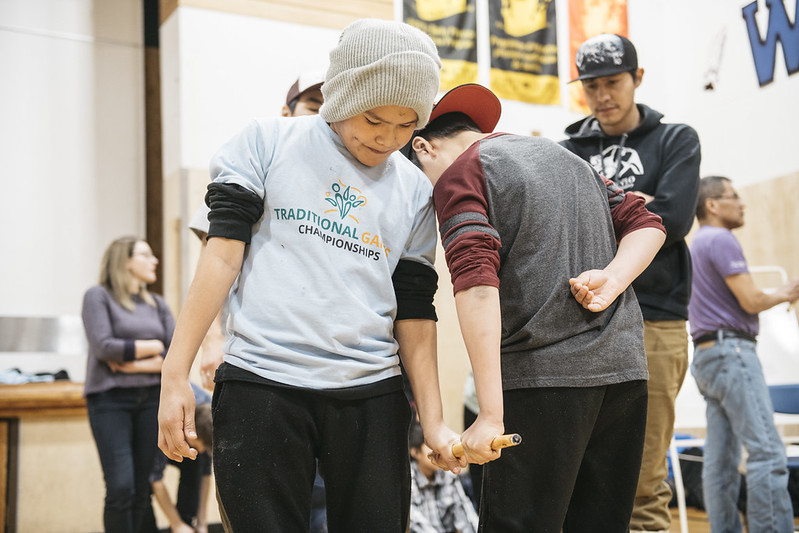
What you need to play Dene stick pull
- A spruce, pine or birch stick shaved to a size you can grip comfortably (ideally 30 cm long with a centre diameter of 2.5 cm, tapering off approximately 1.3 cm at each end). The stick needs to be polished smoothly to prevent injury, and it should either have one or three marked lines: one at the centre point and the other two 1.3 cm on both sides of the center line.
- Lard
- Paper towels
How to play Dene stick pull
- Thoroughly grease the stick with lard.
- Stand beside your opponent with the outsides of your feet touching, hips near enough to touch. Your other foot can be staggered to ensure an even pull.
- Long sleeves should be rolled up above your elbows. You can look down to see where you’re holding the stick.
- With your pulling arms extended straight down towards the ground, grasp the stick with your index fingers and thumbs facing each other. The elbow of your pulling hand must remain in this locked position, and your heels or toes can’t be raised off the floor.
- Start pulling strongly and steadily without any jerking movements or bending of your elbow, focusing on pulling the stick beyond your buttocks or hip.
- Whoever can pull the stick from their opponent’s hand or hold the stick beyond their own hip for eight seconds wins the match.
- Play in a best out of three format. If there is a tie after the first two pulls, flip a coin to determine which arm to use for the third pull. The winner of the first match makes the coin call.
Whether it’s kneel jump, snow snake or Dene stick pull, learning about and participating in these sports can help you be active while contributing to the understanding and preservation of the diverse histories and cultures of Indigenous people.
*There is an inherent risk for injury when participating in any physical activity. Consult your health practitioner to see if physical activity is safe for you. When active, ensure you are in a safe area, and stop what you are doing if you experience any discomfort. ParticipACTION is not responsible for any injury or harm you sustain as a result of being physically active.





